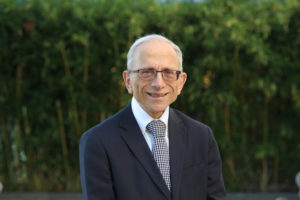
In May, the Weitzman National Museum of American Jewish History will reopen for the first time since the pandemic broke out two years ago, according to Misha Galperin, the museum’s president and CEO.
And it will do so with a new exhibit about an event that just happened: the January synagogue hostage crisis in Colleyville, Texas.
The exhibit will use the Colleyville crisis, in which an armed British-Pakistani man held four Jews hostage, as anecdotal evidence of the larger rise in antisemitism in the United States since around 2015.
Antisemitic incidents in the U.S. have reached record highs during this period, according to the Anti-Defamation League. The stretch includes the 2017 white supremacist rally in Charlottesville, Virginia; the 2018 Tree of Life shooting in Pittsburgh; and the 2019 synagogue stabbing in Monsey, New York.
Brandeis University professor and American Jewish historian Jonathan Sarna is also the chief historian at the Weitzman, and, in that role, he has pushed the museum to start emphasizing modern history. According to Sarna, many American Jews forgot that antisemitism was a potent force and still need to be reminded that it has long been a part of the American Jewish experience.
Museum officials, led by Galperin, agreed and wanted to time their first such exhibit with their reopening. So after the January crisis, in which all four hostages escaped unharmed, Galperin and company reached out to the synagogue, Congregation Beth Israel, to procure some materials.
“We thought it was an important historical event and that it was important to tell the story,” the CEO said.
The formerly named National Museum of American Jewish History filed for bankruptcy in March 2020, around the same time that it closed due to COVID. But in December, an eight-figure gift from luxury shoe designer Stuart Weitzman helped it survive and, ultimately, reopen to the public.
Its new core exhibit will consist of a series of artifacts from that frightening day in Texas, including the cup in which Rabbi Charlie Cytron-Walker made tea for the terrorist, who was posing as a homeless man, and the chair that the rabbi later threw at the man to help the hostages escape.
Sarna is also going to interview Cytron-Walker and two other hostages in a video to accompany the artifacts.
Museums, as both Galperin and Sarna explained, function best by using symbols. They aren’t books or encyclopedias; they aren’t going to tell you everything. So they use big examples to reflect a larger context.
In this case, the Colleyville crisis will lead museum visitors into the modern story of antisemitism. It will then be complemented by programs, both virtual and in-person, and statistics that explain the larger context, including this one, cited by Galperin: 58% of religiously based hate crimes are against Jews, even though Jews are less than 2% of the population.
“Antisemitism, including its newest form, anti-Zionism, seems to be tolerated easier than other forms of racism,” he said.
Galperin moved to the United States from Ukraine in the 1970s to escape antisemitism and, for a while, he did. He quickly realized that American Jews weren’t worried about it like he was.

Sarna’s scholarship and lectures focus on a similar theme. The professor often refers to Jewish historians in the 1990s who proclaimed “the end of American antisemitism,” he said.
But in the 2010s, thanks to a variety of forces like changing demographics, hollowing towns, reeling elites and the rise of social media, antisemitism came roaring back, according to Sarna. Now, Jewish historians and museums need to bridge those eras so that American Jews understand their connection.
Before the new exhibit, the Weitzman was not doing that. It last updated its building and core exhibition in 2010, according to Galperin.
“You want a historical exhibit to reach up to the present,” Sarna said. “Life has changed. You can’t freeze time.”
The Weitzman is the nation’s only institution whose focus is on the entire history of American Jewry, per the CEO. And with the Colleyville display, the museum sees itself as taking on a national leadership role.
Museum officials are rolling out the exhibit in May to align with Jewish American Heritage Month, a recognition that dates to George W. Bush’s presidency. Today, more than 100 organizations and institutions across the nation participate, Galperin said.
Once May ends, the Weitzman will keep the Colleyville artifacts on display for at least a year. Then it may set up a traveling exhibition as it has done with past exhibits.
“If you don’t know your history, you’re bound to repeat it,” Galperin said. JE
[email protected]; 215-832-0740






